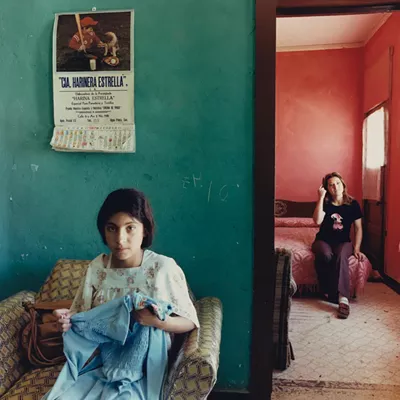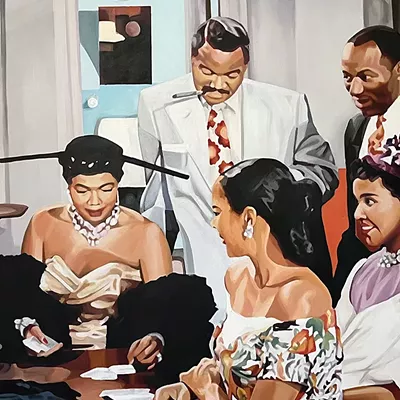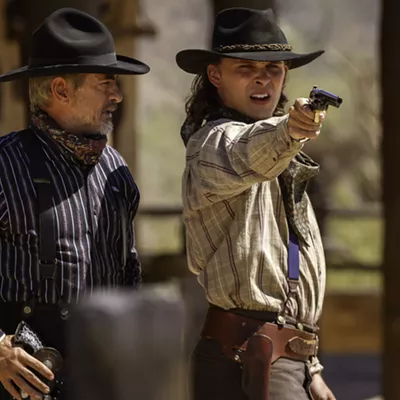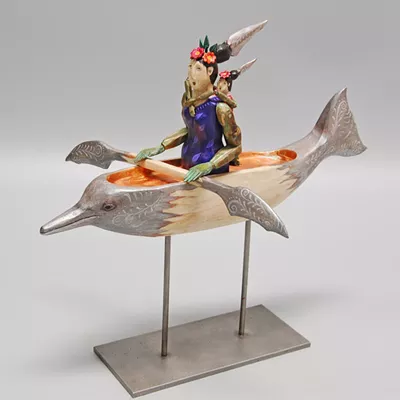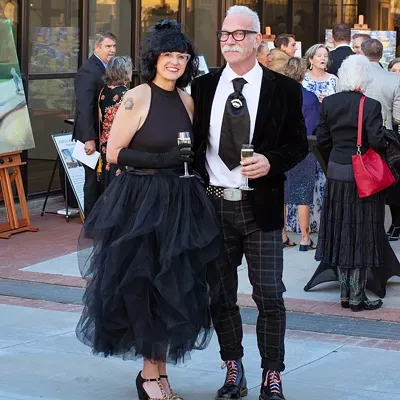On the perimeter of Hermosillo, far from downtown's plaza and cathedral, a bevy of abandoned warehouses slowly crumbled for years.
Called wineries by the locals, the old buildings became home to the homeless, to migrants, to the mentally ill, to the dispossessed. Inside these cavernous spaces, people slept among the rubble, almost invisible beneath their blankets and repurposed trash bags.
Many inhabitants etched graffiti onto the disintegrating walls, leaving undecipherable messages and startling drawings. In one sketch on a pillar, an agonized human face stared outward, the very picture of despair.
A young Hermosillo photographer, Nahatan Navarro, now just 32 years old, documented this small universe before it vanished, tumbled to the ground by order of the city. His series on this hidden world and its inhabitants is aptly named Los que se quedan/Those Who Stay.
His searing digital images of these dark indoor spaces, pierced here and there by beams of light, are a highlight of Separados por Frontera/Separated by Borders at Louis Bernal Gallery at Pima College West Campus. The four artists in the show, all with connections to Hermosillo and Sonora, provide a welcome window into contemporary art across the borderline.
Navarro's inventive works read almost as abstract paintings. They're in color, but the hues are somber. Stained by industrial materials, textured by the rough etchings, the massive walls are beige and gray. Still, the artist finds patches of color everywhere he looks. A cool blue light floods the floor at the left in one image; warm sunlight comes in from the right lights up the drawings on the wall. A delicate branch on the floor, dragged in by a resident, shines silver.
The colors also help you locate the hard-to-find inhabitants. One man dwarfed by the building's size is collapsed in sleep on the floor; you notice him only when you see the bright blue of his shirt. Elsewhere, a blue-flowered sheet hangs on a clothesline in a sunny doorway, a stand-in for the poor soul who lives there.
Four photos of the bright outdoors are a relief from the buildings' shadowy depths. There's a bright blue Mexican sky, yellow-ochre weeds by the railroad tracks, sunlight glistening on a whitewashed wall. Even so, the outdoor structures are formidable barriers.
In several head-on portraits, the men seem hemmed in by the walls behind them. But they are all distinctive individuals. Navarro compassionately records in great details the signs of their hard-lived lives: the furrows in their faces, the tangles in their hair, the grimness of their expressions.
Artist Miriam Yisel Salado Esquer, originally from Sonora, makes 3-D works and large-scale drawings. She's now based in Mexico City, as is Carlos Iván Hernández, a sculptor and photographer. But the married couple, both in their early 30s, are exhibiting work tightly tied to the Sonoran ecosystem.
While Navarro specializes in social justice art about human tragedies, Salado concentrates on the needs of nature, making handsome works that are part of what she calls her "ecological investigation." Working in the coastal region west of Hermosillo, she collects whale bones and turtle parts at Kino Bay and cattle bones on inland ranches.
For this show, she's exhibiting three large drawings of the whale bones, delicately rendered in graphite pencil on white cotton paper. "Detritus I, II and III." Her bones, floating in space, are as detailed at Navarro's faces, masterworks in line and light and shadow.
Even more striking work is a 3-D white plaster sea turtle prostrate on the floor. Titled "Fossil Remains/Restos fósiles," the sculptural work honors the endangered sea turtle of the Sea of Cortez, a prized animal still heavily hunted for its meat, both for local consumption and for sale abroad as an exotic delicacy.
To make the piece, Salado used an actual turtle shell as a mold, pouring the wet plaster inside. In the sculpture, the plaster pieces are broken; they're piled atop each other, roughly in the shape of the animal. Between those broken shards and their ghostly white and gray hues, the work turns into a solemn requiem for the turtle.
Hernández also works in a pale palette of whites and grays, and he also zeros in on the natural world of Sonora. His State of Nature/Estado de naturaleza" is a series of transient 3-D works that he captures permanently in evocative photographs, which he's showing in the gallery.
He collects the traditional building materials that Sonoran farmers have used for centuries: mud, cow manure, grass and ocotillo rods. He slaps the soft materials into an adobe mud, pushes them into a variety of shapes reminiscent of birds, hills, feet and walls, and plants them in what look like rural sites.
In "State of Nature III," Hernandez has woven the ocotillo rods into an airy irregular grid that rises out of two mud forms. "State of Nature II" plops a bird-like wad of the adobe on three ocotillo rods standing in as legs.
"State of Nature IV" comes closest to replicating a traditional country wall in Mexico. It stands upright, sort of: it's organic and twisty and curving, destined to return to the earth it came from—not at all like the cold steel border barriers now on everyone's mind in the borderlands and the corridors of D.C.
The fourth participant in the show, Francisco Larios Osuna, is a successful interdisciplinary artist in his 50s who shows in Mexico City and abroad, and has works in the permanent collections of contemporary museums in the U.S. and Latin America.In Separados, he exhibits shimmering wall works in enamel and ink on gold leaf and wood. The pieces are pure abstractions, with dozens and dozens of highly disciplined straight lines forming glistening geometric shapes that veer into optical illusions. Still, with Mexico on my mind, to me they seem to allude subtly to the geometrics in Aztec designs of long ago.


